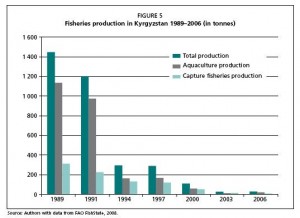This is what’s happened to inland fisheries pretty much throughout Central Asia since the fall of the Soviet Union:

According to an FAO report just out, that is. There’s some limited scope for optimism, though.
Somewhat belatedly, attention is now being focused upon the reactivation of the fisheries sector with the emphasis very much on aquaculture as it is unlikely even in the Caspian Sea that capture fishery could ever again assume the same importance as in yesteryear. Led by private entrepreneurs, and with the active prompting of national fisheries departments and foreign donors, fisheries are being slowly restored to the developmental agenda. This is no easy task, given both the general failure to recognize the role the sector can play in national development and poverty alleviation strategies and the continued lack of legislative clarity, although the latter is gradually being rectified in a number of the countries.
It will be interesting to see whether any recovery is based on a reasonable foundation of fish diversity (Kazakhstan has 150 fish species), or just the usual one or two aquaculture suspects.